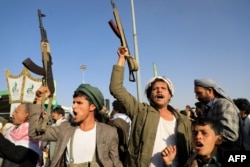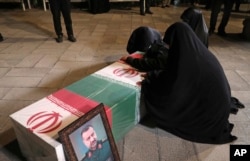Iran is eager to build on its longstanding alliance with Syria, but Tehran's achievements in expanding its influence in the Arab country are threatening one of its primary objectives: staying out of the line of fire in its shadow wars in the Middle East.
As Iranian Foreign Minister Hossein Amir-Abdollahian said earlier this month during a trip to Damascus on the anniversary of the 1979 Islamic Revolution, Tehran considers Syria to be on the front line of its "axis of resistance," its loose network of proxies and Tehran-backed militant groups against Israel and the United States.
After meeting on February 11 with top Syrian officials and President Bashar al-Assad, Amir-Abdollahian stressed the important role Damascus plays in opposing its enemies and in establishing "stability and security" in the increasingly volatile region.
But while Iran's top diplomat cited the ongoing war in the Gaza Strip as a position of strength for the axis and a stimulus of increased cooperation with Damascus, observers and media reports suggest that direct blowback against Iranian interests and personnel in Syria is prompting Tehran to recalculate its approach.
Generational Relationship
Iran has invested heavily into its relations with Syria for decades as part of the Shi'ite Islamic republic's effort to export its revolution across the Arab and Muslim world.
"The Iranians made big inroads with Hafez al-Assad, the father of the current leader of Syria, when they issued a religious ruling that Alawites -- the religion of the ruling family -- were deemed to be an orthodox, or acceptable, sect of Shi'ism," according to Thanassis Cambanis, director of the U.S.-based Century Foundation think tank.
The ruling was the first of many steps in "a really deep, generational, state-to-state relationship between Iran and Syria," Cambanis said.
Ties strengthened further during the early rule of Bashar al-Assad following the U.S. invasion of Iraq in 2003.
"Assad was a relatively young ruler, he feared a U.S. invasion, and he found that a growing partnership in coordination with Iran kept him more secure in his own domestic power base, and also kept him more secure vis-a-vis the threat of some kind of U.S, or U.S.-orchestrated, regime-change project," Cambanis said.
That bet appears to have paid off for both Iran and the Syrian government.
Assad remains securely in power despite the continuing Syrian civil war, in which Iran intervened militarily in 2013 in large part to prevent Assad's ouster by the U.S.-backed opposition.
Tehran, meanwhile, has managed to significantly boost its influence in Syria without maintaining a significant military presence by deploying hundreds of Islamic Revolutionary Guards Corps (IRGC) officers to recruit and train tens of thousands of local and foreign Shi'ite fighters.
"The actual number of IRGC forces is very limited," said Hamidreza Azizi, a fellow at the German Institute for International and Security Affairs in Berlin, adding that the heavy lifting of the fighting in Syria is carried out by Afghans in the Fatemiyun Brigade and Pakistanis in the Zainabiyn Brigade, as well as by Iraqi militias.
Iran has also established a land corridor linking it to the Levant that Azizi described as the "logistical backbone of the axis of resistance."
Apart from Iran, Syria is the only other state actor in the axis.
The corridor "is used by Iran to send arms and equipment to [Lebanese] Hizballah," Azizi said, referring to the IRGC-created militant group that has rained missiles down on Israel since the start of the war in Gaza.
It is also used "to facilitate the back-and-forth deployment of troops on both sides of the Iraqi-Syrian border," which Azizi said has essentially become an arena of operations for pro-Iran militias.
Success In Syria
Beginning in 2018, victories in the Syrian civil war allowed Iran to reduce its IRGC presence, Azizi said, with foreign mercenaries and local fighters it trained increasingly integrated into the Syrian armed forces. In a major contrast to the beginning of the war that erupted in 2011, Azizi added, most of the recruitment and training of forces in Syria was handed off by the IRGC to Hizballah.
Successes in Syria also allowed Tehran to buttress its defenses against the possibility of an attack on Iranian soil by Israel.
"Once Iran achieved its strategic objectives of securing the survival of the Assad regime and the overland corridor, the IRGC defined the new objective of establishing a new dormant front against Israel along the Israel-Syria border," said Ali Alfoneh, senior fellow at the Arab Gulf States Institute in Washington. "The purpose of the dormant front is to complicate Israeli calculations should the Jewish state decide to bomb Iran’s nuclear facilities."
All the while, Iran has put pressure on Israel and the United States while maintaining its key objective of avoiding direct war, with the proxy fighters it trained and equipped absorbing most retaliatory blows in Syria.
"Since neither Syria nor Iran [is] interested in a direct war against Israel, the three states, through their actions, negotiated the rules of the game: The IRGC’s expendable allies such as the Afghans dig deep trenches and tunnels along the Israel border, Israel bombs the positions; Iran does not retaliate against Israel; and the Assad regime remains a spectator," Alfoneh said in written comments.
"All three players still largely abide by these rules, which remain in place despite the Gaza war, and the U.S. neither is nor desires to get entangled in this game," Azizi wrote.
Rules Broken
That is not to say those unspoken rules are not being broken following the outbreak of the war in Gaza sparked by the deadly October 7 assault on Israel carried out by Palestinian extremist group Hamas, which is considered a terrorist organization by the United States and the European Union.
Israel's large-scale retaliation in Gaza has fueled attacks by the axis of resistance in solidarity with its partner Hamas and in the name of the Palestinian cause.
Hizballah has led the fight against Israel, while the Iranian-backed Huthi rebels in Yemen have launched attacks against Israel and U.S. naval forces in the Red Sea. And Iranian-backed forces have attacked U.S. forces in the Middle East, including a drone attack launched by an Iraqi militia that killed three U.S. troops in Jordan in January.
In Syria, U.S. forces stationed there to counter the Islamic State extremist group have been attacked regularly since the onset of the war in Gaza, including a February 5 drone attack that killed U.S.-allied Kurdish troops at the largest U.S. base in Syria, located in the eastern province of Deir al-Zur.
Amid the rising tensions, Tehran has not been able to avoid direct retaliation for its open support for its proxies and partners, and Iranian sites and personnel in Syria have been hit hard.
Since December, more than a dozen IRGC commanders and officers officially sent to Syria as advisers have been killed in strikes in and around Damascus blamed on Israel, including General Sayyed Razi Musavi, a senior adviser to the IRGC and one of Iran's most influential military figures in Syria.
And the United States, in retaliation for the attack on its base in Jordan, in early February directly attacked IRGC sites and Iranian-backed militias on either side of the Syrian-Iraqi border.
Both the United States and Iran have said they do not seek war. And in Syria, Cambanis said, there are "certain rules of the road that are essentially designed to create useful fictions so that the U.S. and Iran do not end up in direct conflict with each other."
But since the October 7 Hamas assault on Israel, Cambanis said, "there are so many forces attacking each other on Syrian territory that it’s really easy for just a mistake or a miscalculation that no one wanted."
Recalculation Time?
In the wake of the killings of Musavi and other top IRGC personnel, an exclusive report by Reuters earlier this month cited multiple sources as saying Iran had scaled down its deployment of senior officers and would rely more on allied Sh'ite militias to maintain Iranian influence in Syria.
Azizi said that while previously, if Iranians were killed as the result of Israeli strikes in Syria, it was essentially written off as collateral damage.
"But now they are the targets," Azizi said. "And that's what concerns Iran, especially since the killing of Musavi."
But while the deaths indicate a change in strategy by Israel that at the least "requires the Iranian side to change tactics," Azizi suggested the redeployment was more about trying to determine possible leaks that may have allowed Israel to take out its officers and rethinking how Iran would use its personnel in the future.
Cambanis expressed skepticism that Iran would ever withdraw its advisers in Syria and hand their responsibilities over to the militias they trained.
"They have officers who speak Arabic, who have spent decades cycling in and out of different positions in Syria and other Arab countries. They have local knowledge, long-term relationships with local commanders," Cambanis said. "They're going to continue that model."
This content originally appeared on News - Radio Free Europe / Radio Liberty and was authored by News - Radio Free Europe / Radio Liberty.
News - Radio Free Europe / Radio Liberty | Radio Free (2024-03-04T19:56:39+00:00) Top Iranian Sunni Cleric Barred From Touring Flood Sites In Baluchistan. Retrieved from https://www.radiofree.org/2024/03/04/top-iranian-sunni-cleric-barred-from-touring-flood-sites-in-baluchistan/
Please log in to upload a file.
There are no updates yet.
Click the Upload button above to add an update.

